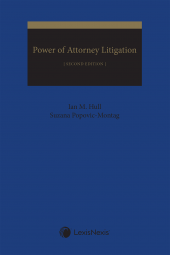Advising Families on Succession Planning - The High Price of Not Talking
One Year Subscription Only Terms
Subscribers receive the product(s) listed on the Order Form and any Updates made available during the annual subscription period. Shipping and handling fees are not included in the annual price.
Subscribers are advised of the number of Updates that were made to the particular publication the prior year. The number of Updates may vary due to developments in the law and other publishing issues, but subscribers may use this as a rough estimate of future shipments. Subscribers may call Customer Support at 800-833-9844 for additional information.
Subscribers may cancel this subscription by: calling Customer Support at 800-833-9844; emailing customer.support@lexisnexis.com; or returning the invoice marked 'CANCEL'.
If subscribers cancel within 30 days after the product is ordered or received and return the product at their expense, then they will receive a full credit of the price for the annual subscription.
If subscribers cancel between 31 and 60 days after the invoice date and return the product at their expense, then they will receive a 5/6th credit of the price for the annual subscription. No credit will be given for cancellations more than 60 days after the invoice date. To receive any credit, subscriber must return all product(s) shipped during the year at their expense within the applicable cancellation period listed above.
Product description
The cost of litigating an estate matters can be enormous - both financially and emotionally. However, most estate litigation can be avoided with advance planning.
This new book will help you explain to clients the benefits (both financial and emotional) of developing an effective and comprehensive estate plan that includes consulting with intended beneficiaries as part of the process. It takes readers through the steps in the estate planning process, discusses how to prevent mistakes from happening, describes the circumstances in which estate plans are challenged, and takes them through a method by which the wishes of intended beneficiaries can be considered.
It is a book that you will want to give to clients as well as have on your bookshelf and in your reception area.
Coverage Includes
Featuring familiar real life scenarios to which clients can relate, the book is divided into three parts:
Part 1 - A Wills and Estates Primer
- Describes each of the three components to an estate plan - wills, tax reduction strategies and powers of attorney - and the steps that can be taken to protect them from challenge
- Takes clients through the steps in the estate planning process, while emphasizing the importance of making their final wishes clear, and discusses how to prevent mistakes from happening
Part 2 - Why Estate Plans are Challenged - and What it Costs
- Identifies the ten most frequent causes of estate litigation and the legal processes and costs associated with bringing a court action challenging a will
- Describes the circumstances which prompts people to challenge estate plans - and the high cost of such challenges.
Part 3 - The Family Conference Solution
- Highlights the importance of considering beneficiaries' wishes and takes you step-by-step through the family conferenceprocess. Includes a discussion on the purpose and wording of a "family constitution", and the steps that need to be taken before a family conference, including:
- How to determine who to invite
- A checklist of what the agenda should cover
- Appointing a chair person
- The role of the mediator
- A sample family conference agreement
- Rules for the meeting and dealing with particularly difficult issues such as extramarital relationships; unequal treatment of children; spendthrift beneficiaries; special needs beneficiaries; family business issues and incentive trusts
Who Should Buy
- Estates and General Practitioners who wish to encourage clients to make wills, in particular wills that will not be challenged in court
Click here to read a review of this title
Table of contents
Chapter 1 The high price of not talking
Part 1 - A Wills and Estates Primer
Chapter 2: What an estate plan should accomplish
Chapter 3: What is a will
Chapter 4: How to bulletproof your will
Chapter 5: The role of the executor
Chapter 6: The executor's income tax and accounting obligations
Chapter 7: The recreational property conundrum
Chapter 8: Taxes that arise on death
Chapter 9: Trusts
Chapter 10: Estate freezes
Chapter 11: Powers of attorney
Part 2 - Why Estate Plans are Challenged - and What it Costs
Chapter 12: Ten most frequent causes of estate litigation
Chapter 13: The legal process and its costs
Part 3 - The Family Conference Solution
Chapter 14: The Family Constitution
Chapter 15: Before the conference
Chapter 16: At the conference
Chapter 17: If family members won't approve your plan
Chapter 18: After the conference
Chapter 19: Conclusion
 Lexis Nexis
Lexis Nexis 


